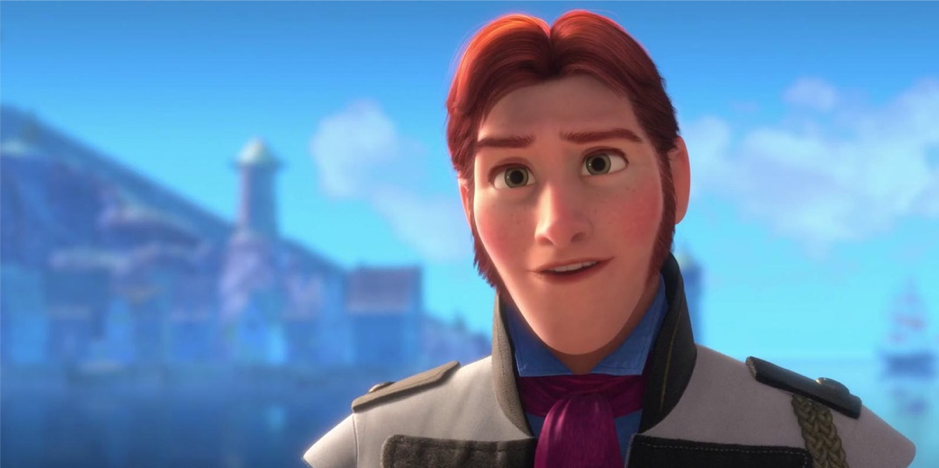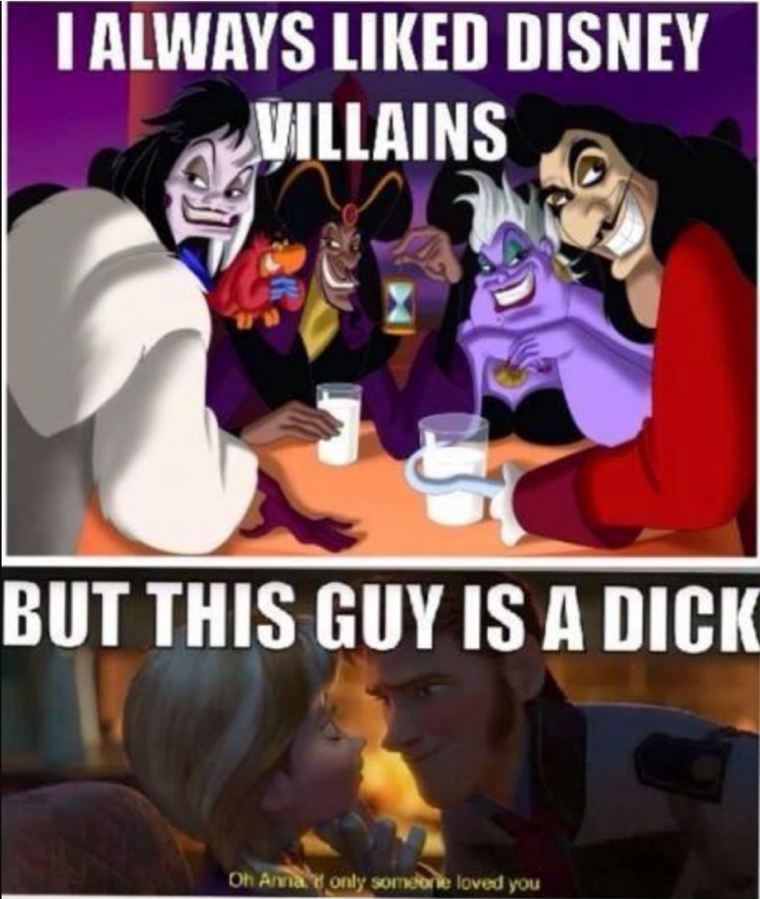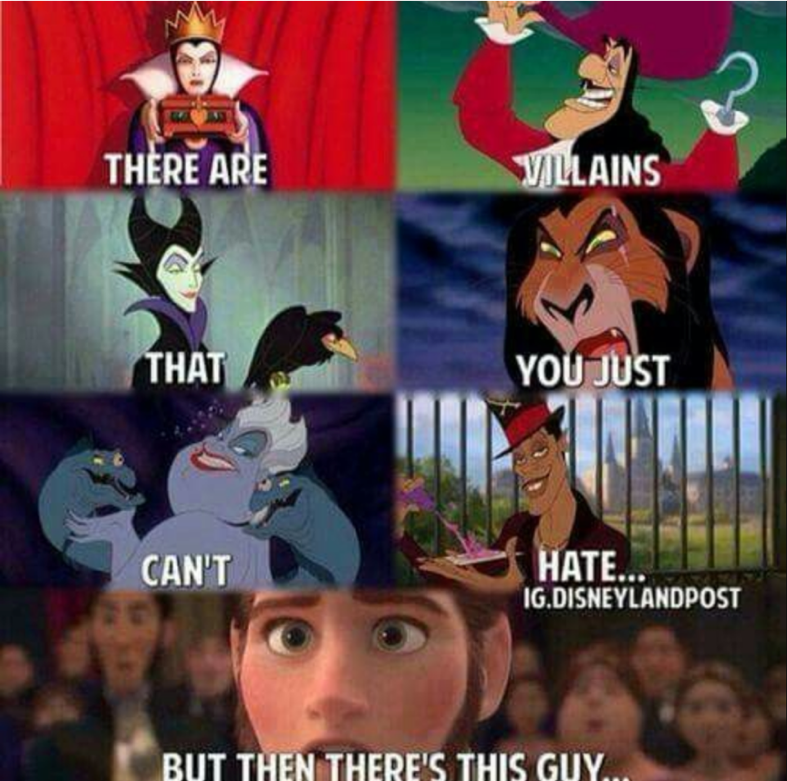Usually, Disney villains are popular and profitable. Characters such as the Evil Queen (Snow White and the Seven Dwarves, 1937), Jafar (Aladdin, 1991), and Ursula (The Little Mermaid, 1989) are showcased in theme park attractions, clothing lines, and even have their own Zales engagement ring collection. While most animated villains from Disney’s Golden Age and Renaissance Era are often represented as the embodiment of evil, there is a certain kind of empathy for their stories and joy that comes from following their journeys.

When Frozen was released in late 2013, audiences had a drastically different reaction to Prince Hans than his Disney villain predecessors. Disdain for the character came in the form of articles, image macros, and memes. In the Atlantic was published an article entitled ‘Frozen’s Cynical Twist on Prince Charming’ wherein are reviewed possible implications that the particular portrayal of evil in Frozen could have on young audiences. The author claims the scariest part of the film was the prince. She states: “There is something uniquely horrifying about finding out that a person, even a fictional person, who’s won you over is, in fact, rotten to the core” (Dalfonzo, 2013, para. 6). While some audience members were horrified, others were furious. For instance, beginning in 2014, hundreds of accounts on Pinterest and Tumblr have circulated an image macro that has multiple pictures of different villains from the Disney canon above a film-still of Prince Hans at the moment he was revealed to be the villain (Figure 2).

Negative reactions to Prince Hans are consistent throughout the content on social media. Many people, including the author of the piece written in the Atlantic, did not enjoy Prince Hans as a character due to his immoral actions, not because he wasn’t well-written. Many critics despised the character while simultaneously loving the film. Still, comparisons to former Disney villains continued to invade social media spaces. Figure 3 showcases an image macro signifying the loathing audiences felt toward Frozen’s twist-villain.

Prince Hans certainly commits an evil act, going so far as to leave Anna to die in order to secure his place as head of a kingdom. However, this act appears no more evil than those of the murderous antagonists of Disney’s past. This begs the question: why such an execrable reaction toward Prince Hans?
Based on uncertainty reduction theory, expectancy violations theory analyzes how people respond to violations of social norms (Burgoon, 1988). By considering expectancies, communicator reward valence, and violation valence, expectancy violations theory can predict how people will respond when what they feel is appropriate for a given situation is disrupted (Griffen, 2011). While predominantly used to interpret interpersonal communication, expectancy violation theory explains the audience distrust of and disgust toward Prince Hans.
The majority of Disney villains are understood to be the antagonist early in their respective films. Cruella de Vil, Ursula, and Jafar are examples of antagonists immediately identified as such upon meeting them, either through a reaction or comment they illicit from another character, an immoral action they commit, or simply by presenting exaggerated features that exist in contrast to the appearance of the protagonist (Li-Vollmer & LaPointe, 2003; Alsip, 2010). Since schemas lead viewers to expect good characters will do good things and bad characters will do bad things (Raney, 2004), an identified villain who commits an immoral action is simply acting in accordance with their expectations. Cruella de Vil can seek to skin puppies for her own luxurious coat, but audiences are aware of this nefarious goal for nearly the entirety of the film. However, twist-villains inherently seek to violate the expectations of their original character, by posing as the good and moral only later to be revealed as the evil and unethical.
An increasingly large number of twist-villains have been added to the Disney and Pixar canon. A twist-villain is much more common in the genre of mystery, where a character is introduced early in the film and only identified as the villain (by both the protagonist and the audience) near the end of the movie. Since 1999, Disney and Pixar have created more than twelve twist-villains, including Stinky Pete (Toy Story 2, 1999), Charles F. Muntz (Up, 2009), and, of course, Prince Hans (Frozen) (Darcy, 2017). Prince Hans, who is originally identified as the Prince Charming trope, acts outside the norm of what is body type, vocal characteristics and general demeanor would have him behave. This results in negative audience reactions toward him. Prince Hans not only violates the norms of his own actions from the beginning of the film but the expectations of Disney animation as a medium, breaking the traditional mold of the Disney villain itself.
As the antagonist in the most profitable animated movie of all time, Prince Hans is the embodiment of a new Disney villain, one that looks, sounds, and acts just like the protagonist, and often times, just like us. Villains are no longer distinguished by their flamboyancy, their weight, or their cackling laugh, they are our friends, family, or even fiancés. Whether a twist-villain leads to a stronger sense of paranoia in our audiences or elicits better critical thinking skills before labeling someone as ‘the bad guy,’ one thing is for certain: Prince Hans will certainly never have his own engagement ring collection.
References
Alsip, M. K. (2010). “Does evil have a shape? Comparing body types of heroes and villains in Disney animations”. Conference Paper — International Communication Association, 1.
Burgoon, J. K., & Hale, J. L. (1988). “Nonverbal expectancy violations: Model elaboration and application to immediacy behaviors”, Communication Monographs, 55(1): 58–79. doi: 10.1080/03637758809376158
Dalfonzo, G. (2013, December 10). “Frozen’s cynical twist on prince charming”, The Atlantic. Retrieved from https://www.theatlantic.com/entertainment/archive/2013/12/-em-frozen- em-s-cynical-twist-on-prince-charming/282204/.
Darcy, J. (2017). Disney villains: Delightfully evil: The creation, the inspiration, the fascination. Los Angeles: Disney Editions.
Griffin, E. (2011). “Chapter 7: Expectancy violations theory.” A first look at communication theory New York, NY: McGraw-Hill, 8th ed.: 84-92.
Li-Vollmer, M., & Lapointe, M. E. (2003). “Gender transgression and villainy in animated film”, Popular Communication, 1(2), 89–109. doi: 10.1207/s15405710pc0102_2
Raney, A. A. (2004). “Expanding disposition theory: Reconsidering character liking, moral evaluations, and enjoyment”, Communication Theory, 14: 348–369.
Bailey Patterson is a first-year master’s student in the department of communication and journalism at the University of Wyoming. Her current research interests include performance studies, the integration of trait theory and character development for live theatrical performance, as well as the portrayal of antagonism in children’s media.

3D, Vfx animation services